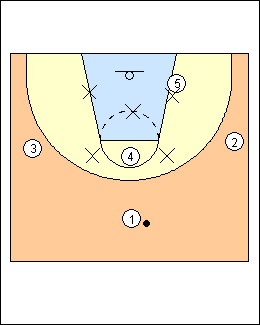Steve Bzomowski
 | 1 Never Too Late Basketball Against any zone, 1) line up in the gaps (shown) 2) perimeter players look to dribble the ball into the gaps between defenders, get two players to guard you 3) use pass fakes to move the defence (put the ball overhead) 4) get the ball inside to the post players to collapse the defence, not necessarily to score (post players move toward the ball with both hands high overhead 5) when post players catch, they immediately square up to the hoop and think a) am I open, b) is my post teammate open, c) if neither a) or b) kick the ball out to the weak side, or opposite where the ball just came from 6) one post player should run the baseline, behind the bottom line of the defence as much as possible to flatten out the zone, to get inside defenders turning their heads and to give more room and opportunities to catch in the paint 7) when a cutter goes through, the cutter creates a vacuum that a teammate should step into to receive a scoring pass. |
 | 2 Against man-to-man you want player movement, against zones you want ball movement. There should be no turnovers against zones, perimeter players should step way out to get reversals. If the defence challenges outside passes, that just opens up the middle. Use back screens on the baseline and wings. Use skip passes generally, and skip passes specifically on back screens. When not penetrating or using ball fakes, move the ball quickly. You can run a zone attack with no cutters against a 2-3 using a point guard, two wings, high-post low-post exchanging scheme, and against 1-2-2 or 1-3-1 you can use two guards, a high post, low post and corner attacker (shown). Post players in both scenarios should exchange using an X-cut pattern almost every time the ball is reversed. |
 | 3 Perimeter players should constantly be adjusting their positions as the defence moves. The flatter the zone gets, or the more it collapses, the more they can step in; the higher the defence steps out, the farther out the offence should step. Perimeter players should stay 12-15 feet from a line between the two defenders they are splitting (you're always in a gap between two defenders), perpendicular to the mid-point of that line. Here 3 is splitting two defenders on a perpendicular. On a pass to 2, the elbow defender dives into the middle of the lane, and 3 adjusts his position to stay on a perpendicular 10-12 feet from the mid-point of a line between the two defenders. 3 is open in the best place to catch and shoot. |
This page was made with Basketball playbook from Jes-Soft